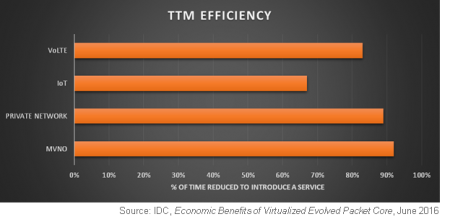
We just released a white paper from IDC that shows how new solutions for mobile networks can impact operator costs. Yes, virtualization does make a difference, no doubt. However, IDC broke new ground by analyzing the benefits that 5G innovations can deliver to mobile operators, as well. IDC found that a 5G-ready virtualized mobile core network could save 50% more than virtualization alone over five years. The key advantage comes from deploying a distributed architecture with control and user plane separation (CUPS). In addition, that same environment could reduce the time to introduce certain new services by 67% or more.
The white paper also discusses the market dynamics that make moving to software an imperative. Mobile operators need to compete more effectively with non-traditional service providers. They also must find opportunities to grow revenues faster than the 2% CAGR forecast for today’s core services. Moving to software, virtualization, and 5G innovations positions operators to succeed. These technologies provide elastic capacity that scales up and down with network demands automatically. The flexibility and intelligence they bring make it much simpler to add new functions and to create new services quickly. These resilient services can even heal themselves.

IDC took a fresh approach to studying this topic. IDC interviewed a number of mobile operators to learn about their experiences with and priorities for network virtualization. IDC also evaluated how a 5G-like distributed architecture might impact mobile network operations. With these insights, IDC developed a real-world scenario to model, where the efficiencies grow over time and don’t start at 100% on day one. In the model, benefits increase as MNOs extend network changes further and optimize them. For example, annual savings from 5G innovations expand each year until they are 80% greater than vEPC alone in 2020. This approach differs from many analyses that take one use case and make a simple comparison between solution A and solution B. Most operators will not have the luxury of such a greenfield deployment. IDC even highlights how they need solutions that give them choices in how to leverage their existing mobile network assets as they move into the virtualized, 5G world.
What does the study mean for Cisco and how we can best help you, our mobile service provider customers? Our Open Network Architecture lets you combine hardware based and software based assets to create a single easy to use architecture powered by SDN. We give you maximum flexibility to transform your networks in the manner and at the speed that makes sense for you. Network Services Orchestrator can create services using network functions that are physical, virtual, or combinations of both. This makes integrating with and migrating from current assets seamless. Cisco NFV Infrastructure provides a pre-integrated, optimized platform on which to run your NFV solutions.

Cisco Ultra Services Platform is the core of the Cisco offer for mobile networks. You can implement a full set of EPC functions. You can co-locate these functions or distribute them where they fit your network best. Cisco Ultra also delivers today the CUPS capability you need for your 5G future. You can separate the control functions of a PGW from its user plane functions. This allows you to control your PGW user plane from a small set of core locations while putting the data handling functions of the PGW in places closer to your UEs to help you optimize your network and your customer experience. A distributed architecture also makes your network more scalable and allows you to roll out new services across a large footprint faster. With Cisco Ultra you also get Gi-LAN services available to distribute along with the user plane – again providing greater flexibility to optimize how you deliver those services.
Even with all of this capability, Cisco Ultra provides an open environment. You can integrate 3rd-party EPC functions and/or Gi-LAN services using ETSI-standard interfaces. You can run it on your choice of NFVi and orchestrate it with your own or another vendor’s solution. You choose the amount of proprietary software you want to create. You decide to what extent you desire a multivendor deployment, as well.
So check out the whitepaper to see IDC’s brand new insights into the benefits 5G innovations can add on top of virtualization. Then check out how Cisco Ultra matches up with the critical difference makers for lowering your costs as you migrate to a more software-based mobile network.

CONNECT WITH US